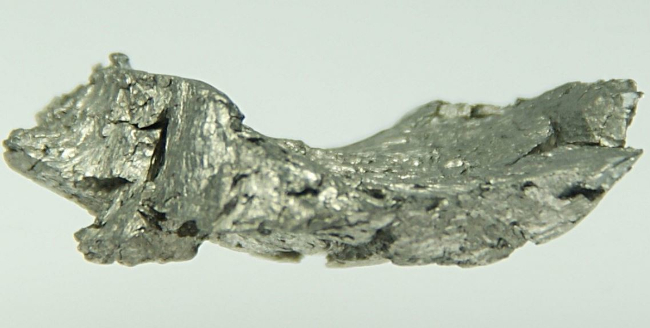
Gadolinium (Gd) is a chemical element of the periodic table, located in the period 6, and has the atomic number 64. It is the eighth element in the lanthanide series. It is slightly malleable, ductile, silvery metal, which is named after the mineral gadolinite, in honour of Johan Gadolin, a Finnish chemist and geologist. It is counted as one of the rare earth elements.
On periodic table
| group | ⇨ | 1 | 2 | 3 | 4 | 5 | 6 | 7 | 8 | 9 | 10 | 11 | 12 | 13 | 14 | 15 | 16 | 17 | 18 |
| period | ⇩ | ||||||||||||||||||
| 1 | 1 H  Hydrogen |
2 He  Helium |
|||||||||||||||||
| 2 | 3 Li  Lithium |
4 Be  Beryllium |
5 B  Boron |
6 C  Carbon |
7 N  Nitrogen |
8 O  Oxygen |
9 F  Fluorine |
10 Ne  Neon |
|||||||||||
| 3 | 11 Na  Sodium |
12 Mg  Magnesium |
13 Al  Aluminium |
14 Si Silicon |
15 P  Phosphorus |
16 S  Sulfur |
17 Cl  Chlorine |
18 Ar  Argon |
|||||||||||
| 4 | 19 K  Potassium |
20 Ca  Calcium |
21 Sc  Scandium |
22 Ti  Titanium |
23 V  Vanadium |
24 Cr  Chromium |
25 Mn  Manganese |
26 Fe  Iron |
27 Co  Cobalt |
28 Ni  Nickel |
29 Cu  Copper |
30 Zn  Zinc |
31 Ga  Gallium |
32 Ge  Germanium |
33 As  Arsenic |
34 Se  Selenium |
35 Br  Bromine |
36 Kr  Krypton |
|
| 5 | 37 Rb  Rubidium |
38 Sr  Strontium |
39 Y  Yttrium |
40 Zr  Zirconium |
41 Nb  Niobium |
42 Mo  Molybdenum |
43 Tc  Technetium |
44 Ru  Ruthenium |
45 Rh  Rhodium |
46 Pd  Palladium |
47 Ag  Silver |
48 Cd  Cadmium |
49 In  Indium |
50 Sn  Tin |
51 Sb  Antimony |
52 Te  Tellurium |
53 I  Iodine |
54 Xe  Xenon |
|
| 6 | 55 Cs  Caesium |
56 Ba  Barium |
72 Hf  Hafnium |
73 Ta  Tantalum |
74 W  Tungsten |
75 Re  Rhenium |
76 Os  Osmium |
77 Ir  Iridium |
78 Pt  Platinum |
79 Au  Gold |
80 Hg  Mercury |
81 Tl  Thallium |
82 Pb  Lead |
83 Bi  Bismuth |
84 Po  Polonium |
85 At  Astatine |
86 Rn  Radon |
||
| 7 | 87 Fr  Francium |
88 Ra  Radium |
104 Rf  Rutherfordium |
105 Db  Dubnium |
106 Sg  Seaborgium |
107 Bh  Bohrium |
108 Hs  Hassium |
109 Mt  Meitnerium |
110 Ds  Darmstadtium |
111 Rg  Roentgenium |
112 Cn  Copernicium |
113 Nh  Nihonium |
114 Fl  Flerovium |
115 Mc  Moscovium |
116 Lv  Livermorium |
117 Ts  Tennessine |
118 Og  Oganesson |
||
| 57 La  Lanthanum |
58 Ce  Cerium |
59 Pr  Praseodymium |
60 Nd  Neodymium |
61 Pm  Promethium |
62 Sm  Samarium |
63 Eu  Europium |
64 Gd Gadolinium |
65 Tb  Terbium |
66 Dy  Dysprosium |
67 Ho  Holmium |
68 Er  Erbium |
69 Tm  Thulium |
70 Yb  Ytterbium |
71 Lu  Lutetium |
|||||
| 89 Ac  Actinium |
90 Th  Thorium |
91 Pa  Protactinium |
92 U  Uranium |
93 Np  Neptunium |
94 Pu  Plutonium |
95 Am  Americium |
96 Cm  Curium |
97 Bk  Berkelium |
98 Cf  Californium |
99 Es  Einsteinium |
100 Fm  Fermium |
101 Md  Mendelevium |
102 No  Nobelium |
103 Lr  Lawrencium |
|||||
| – f block |
Gadolinium is a member of the lanthanide series, a group of elements located at the bottom of the periodic table. It can be found in period 6, between europium (Eu) and terbium (Tb).
Element information
 |
|
 |
|
| Origin of name | named after mineral Gadolinite |
| Symbol | Gd |
| Atomic number (Z) | 64 |
| Atomic mass | 157.25 u |
| Block | f-block |
| Period | 6 |
| Classification | Lanthanide |
| Atomic radius | 180 pm |
| Covalent radius | 196±6 pm |
| Melting point | 1312 ℃, 2394 ℉, 1585 K |
| Boiling point | 3000 ℃, 5432 ℉, 3273 K |
| Electron configuration | [Xe] 4f7 5d1 6s2 |
| Electrons per shell | 2, 8, 18, 25, 9, 2 |
| Crystal structure | Hexagonal close-packed (hcp) |
| Phase at r.t | Solid |
| Density near r.t | 7.90 g/cm3 |
| Main isotopes | Gadolinium-154, Gadolinium-155, Gadolinium-156, Gadolinium-157, Gadolinium-158, Gadolinium-160 |
| Natural occurrence | Primordial |
| Oxidation state | +3 |
| Electronegativity (Pauling scale) | 1.20 |
| Protons Neutrons Electrons |
64 93 64 |
| CAS number | 7440-54-2 |
| Discovered by | CarlJean Charles Galissard de Marignac in 1880 |
History

Gadolinium, a rare earth element, was discovered by Swiss chemist Jean Charles Galissard de Marignac in 1880. Marignac was studying the mineral samarskite, which contains a variety of rare earth elements, when he noticed an unknown spectral line. He eventually isolated a new element, which he named gadolinium in honor of the Finnish chemist Johan Gadolin. Initially, gadolinium was considered a laboratory curiosity and had no practical applications. However, over time, its unique magnetic and optical properties were discovered, leading to a wide range of applications in industry and medicine. Today, gadolinium is used in MRI contrast agents, nuclear reactors, and electronic components, among other things.
Occurrence and production
Gadolinium is a relatively abundant element in the Earth’s crust, with an average abundance of about 6.2 parts per million. It is typically found in minerals such as gadolinite, monazite, and bastnasite, as well as in some other rare-earth minerals. These minerals are often found in igneous rocks and pegmatites, as well as in hydrothermal veins and in sediments derived from these rocks. The largest reserves of gadolinium are found in China, the United States, and Russia, but it is also found in other countries such as Brazil, India, and Australia.
Gadolinium is typically produced as a byproduct of the extraction of other rare earth metals from their ores. The most common method for producing gadolinium is through ion exchange, in which an aqueous solution of a gadolinium salt is passed through a column filled with a resin containing a chelating agent. The chelating agent binds the gadolinium ions, which are then eluted from the column with an acid solution. The resulting solution is then treated with ammonium carbonate to form a gadolinium hydroxide precipitate, which is then calcined to produce the oxide.
Another method for producing gadolinium is through reduction of the oxide with calcium metal in a vacuum or inert atmosphere. This method is less common but can produce higher-purity gadolinium than the ion exchange method. Gadolinium can also be produced through electrolysis of molten gadolinium chloride, although this method is more expensive and is not commonly used.
After production, the gadolinium is typically further processed to produce high-purity metal or compounds for use in various applications, such as magnetic resonance imaging (MRI) contrast agents, fluorescent lamps, and nuclear reactor control rods.
Properties
Gadolinium is a soft and silvery-white metal that is malleable and ductile. It belongs to the lanthanide series of elements.
It has a relatively high melting point of 1312 ℃ and a boiling point of 3000 ℃.
Gadolinium is paramagnetic at room temperature, meaning it can be magnetized in the presence of an external magnetic field.
It has a high neutron cross-section, making it useful in nuclear reactors for control rods and neutron radiography.
Gadolinium is also known for its ability to enhance contrast in magnetic resonance imaging (MRI) due to its high magnetic moment and its tendency to collect in diseased tissues.
Applications
Gadolinium is commonly used as a contrast agent in MRI scans. When injected into the body, it enhances the contrast of blood vessels and tissues, making them easier to see on the images.
Gadolinium has a high thermal neutron capture cross-section, making it useful in controlling nuclear reactions in nuclear reactors. It is often used as a burnable poison in nuclear fuel to reduce the reactivity of the fuel over time.
Gadolinium is also used in X-ray tubes to produce high-energy X-rays. It is added to the anode of the X-ray tube to improve the tube’s efficiency and reduce the risk of damage due to overheating.
Gadolinium is a highly magnetic element and can be used to create strong magnets. Gadolinium alloys are used in magnetic refrigeration, a technology that uses magnetic fields to cool materials.
Gadolinium is used in the production of electronic devices such as computer memory and compact disks.
Gadolinium can be used to produce luminescent materials, which have applications in lighting and displays.
Gadolinium compounds can act as catalysts in chemical reactions, such as the conversion of carbon monoxide to carbon dioxide.
Interesting facts
Johan Gadolin, a Finnish chemist and mineralogist, is the person after whom gadolinium is named.
Gadolinium has the highest magnetic moment of any element, making it useful for magnetic resonance imaging (MRI) in medical diagnosis.
Gadolinium is also used in neutron radiography and as a neutron absorber in nuclear reactors.
Gadolinium can also be used in the production of high-performance magnets, microwave applications, and electronics.
Gadolinium is highly reactive with oxygen and water, and it can ignite spontaneously in air, which makes its handling and transportation challenging.
Gadolinium is a relatively abundant rare earth element, with an average abundance of about 6.2 parts per million in the Earth’s crust, and it is primarily found in minerals like monazite and bastnasite.
Related
More elements
External links
- https://www.rsc.org/periodic-table/element/64/gadolinium
- https://www.britannica.com/science/gadolinium
- https://en.wikipedia.org/wiki/Gadolinium
- https://www.chemicool.com/elements/gadolinium.html
- https://pubchem.ncbi.nlm.nih.gov/element/Gadolinium
- https://study.com/academy/lesson/gadolinium-element-facts-discovery-properties.html
Deep
Learnool.com was founded by Deep Rana, who is a mechanical engineer by profession and a blogger by passion. He has a good conceptual knowledge on different educational topics and he provides the same on this website. He loves to learn something new everyday and believes that the best utilization of free time is developing a new skill.
